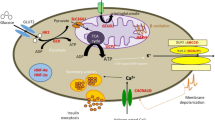Abstract.
Hyperinsulinism is a heterogeneous disorder characterised by severe hypoglycaemia due to an inappropriate oversecretion of insulin. In a personal series of 175 patients investigated for hyperinsulinaemic hypoglycaemia over the last 20 years, we review clinical presentations, molecular studies and therapeutic management of hyperinsulinism. There were 98 neonatal-onset patients, including 86 permanent hyperinsulinism and 12 transient forms, 68 with infancy-onset and nine with childhood-onset. Hyperammonaemia was found in 12 out of 69 patients tested, 4 neonates and 8 infants. Neonates were clinically more severely affected than infants. Diagnosis of infancy-onset hyperinsulinism was often delayed because of less profound hypoglycaemia and better tolerance to hypoglycaemia. Neonates required higher rates of iv glucose than infants to maintain normal plasma glucose levels (16 mg/kg per min versus 12 mg/kg per min). Only 16% of neonates were diazoxide-sensitive compared to 66% of the infants. Neonates with hyperammonaemia or transient hyperinsulinism were diazoxide-sensitive. Most neonates were pancreatectomised whereas 65% of the infants were treated medically. Among surgically-treated patients, 47% had a focal adenomatous hyperplasia (31 neonates and 13 infants) and 53% a diffuse form of hyperinsulinism (39 neonates and 11 infants). Diazoxide-responsiveness in the focal and diffuse forms did not differ in both neonates and infants; it depended only upon the age of onset of hypoglycaemia. One or two mutations, SUR1 or KIR6.2, were found in 41 of 73 neonates who were investigated and in 13/38 infants using polymerase chain reaction-single strand conformational polymorphism analysis of both genes. Almost all patients with SUR1 (38/41) or KIR6.2 (5/7) mutations were resistant to diazoxide. Ten patients with hyperinsulinism-hyperammonaemia syndrome had a mutation in the glutamate dehydrogenase gene (three neonates and seven infants) after reverse transcriptase-polymerase chain reaction and sequence analysis of cDNA. No mutation was found by polymerase chain reaction-single strand conformational polymorphism in the glucokinase gene. Eight of nine patients with childhood onset hyperinsulinism were treated surgically and histological examination confirmed an adenoma in each case. Conclusion: the clinical severity of hyperinsulinism varies mainly with age at onset of hypoglycaemia. The heterogeneity of hyperinsulinism has major consequences in terms of therapeutic outcome and genetic counselling.
Similar content being viewed by others
Author information
Authors and Affiliations
Additional information
Electronic Publication
Rights and permissions
About this article
Cite this article
de Lonlay, P., Fournet, JC., Touati, G. et al. Heterogeneity of persistent hyperinsulinaemic hypoglycaemia. A series of 175 cases. Eur J Pediatr 161, 37–48 (2002). https://doi.org/10.1007/s004310100847
Received:
Revised:
Accepted:
Published:
Issue Date:
DOI: https://doi.org/10.1007/s004310100847



